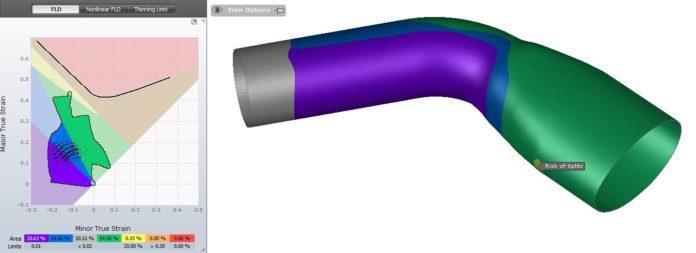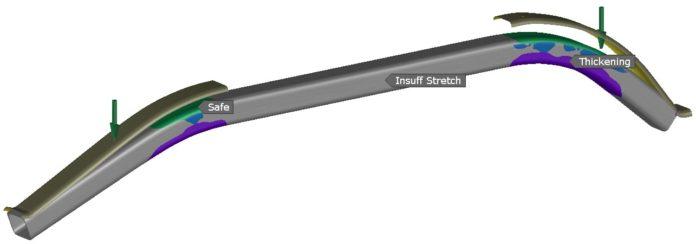![]() Established in 1923 in Alkmaar, the BOSAL Group is a Dutch registered company with its headquarters based in Lummen, Belgium. The family-owned company is a global manufacturer of automotive and industrial equipment for both the original equipment market and the aftermarket. Globally, the company staffs more than 2,500 employees in 16 manufacturing plants, 12 distribution centers and 7 R&D centers. At the R&D center in Lummen, the Process Engineering department and CAE team have been employing AutoForm since 2019. The company also develops and produces fully integrated exhaust systems for passenger vehicles and trucks at this location.
Established in 1923 in Alkmaar, the BOSAL Group is a Dutch registered company with its headquarters based in Lummen, Belgium. The family-owned company is a global manufacturer of automotive and industrial equipment for both the original equipment market and the aftermarket. Globally, the company staffs more than 2,500 employees in 16 manufacturing plants, 12 distribution centers and 7 R&D centers. At the R&D center in Lummen, the Process Engineering department and CAE team have been employing AutoForm since 2019. The company also develops and produces fully integrated exhaust systems for passenger vehicles and trucks at this location.
Top 5 take-aways:
- Using simulation for part/process optimization brings significant savings up to multiple euros for every produced part.
- Even an experienced and creative engineer cannot identify the optimum process without the use of AutoForm.
- Lower bids can be achieved by achieving feasible part design for mechanically formed parts instead of using hydroforming.
- With AutoForm, setting up and running simulations is at least 8 to 10 times faster compared to other simulation software.
- Simulation results elevate customer negotiations to new heights, with discussions based on process videos, reports and quantifiable data.
CAE Manager Eric Hansenne begins, “As a globally operating company, we’re somewhat sizable but compared to other companies active in our field, we are certainly not the biggest player out there. Based on our many years of experience and knowhow, we are recognized within the automotive industry for our expertise and innovations serving nearly all main OEM car companies across the globe. A key strength is our agility, which is unusual for a company of our size and scope. Remaining light and agile means our specialists can communicate directly with counter specialists on the customer side, which has built confidence in us. Our customers are well aware of our technical capabilities and know that we’ve developed parts from reliable simulations over the years. We have developed unique procedures for creating catalytic converters and filters and occasionally, our customers consult us to onboard our unique procedures. One such example is transferring our established method of thermomechanical fatigue analysis to one of the world’s biggest OEMs. This is not our primary bread and butter, however, which is to develop parts for our customers — but our expertise is recognized in numerous aspects.
Costs in Perspective: Tube Hydroforming vs. Mechanical Forming of Tubes
“In our CAE department, we were naturally already quite experienced in the simulation field. We use numerical simulation tools to model, simulate and optimize the overall performance and endurance of the different components in our exhaust systems. However, there is an overall need to reduce CO2 emissions, which among other solutions can be achieved by reducing weight. Reduction of weight means using thinner materials and more complex shapes. Thanks to the increasing popularity of hybrid systems, battery packs are now taking up precious space. This can effectively mean that a smaller dimensional space is left for storing our exhaust components. The performance of our exhaust systems cannot be compromised, of course, so this can cause certain challenges. In the past, we asked our suppliers to provide us with tube forming simulations but due to the increased complexity of requests from our customers, we realized that we could benefit from simulating these kinds of manufacturing processes in-house.

Fig. 1: A recent Bosal simulation project
“During the initial training with AutoForm’s TubeXpert solution, we recognized a benefit right off the bat. We could immediately analyze issues with a product we had been producing for several years but never entirely devoid of problems. The analysis showed that the part should have been hydroformed, which brings us to a very important point. Wherever possible, we stick to mechanically formed tubes instead of hydroformed parts because the production costs are much lower. One of our goals in utilizing the software is therefore to avoid hydroforming — which in turn creates the challenge of determining which parts need to be outsourced, especially as we do not perform hydroforming in-house.”
Head of Process Engineering Jos Reeskens adds, “Consider that the difference between hydroforming and mechanical forming can easily amount to a couple of euros per part. During bidding, such a price disparity can mean the difference between being nominated for the product or not. To provide some perspective, for low volume single production batches, the turnout is ten to fifteen thousand pieces per year over five years. For larger productions, we sometimes reach quantities of two hundred thousand pieces on a yearly basis. So, if we can avoid a hydroformed solution and produce a mechanically formed pipe, this naturally makes a massive difference to us and our customers.
“Offering customers a lower bid is important, but this is an extremely competitive market so we also need to prove that quality is not compromised in any way. To that end, we use the simulation software in discussions with our customers as proof of concept and consequently, as a sales tool. It allows us to prove at a very early stage that we can produce feasible parts in a non-hydroformed process. We can even produce a prototype during the quotation phase to demonstrate that we’ve already achieved their requirements. What has eventuated from the new use of AutoForm is that we are now able to shift even more parts to mechanical forming processes. Last year, we quoted fifteen hydroformed products; this year, we know that twelve of those parts could have been produced without hydroforming. We believe this will save us from seeking external suppliers for hydroformed parts and as a result, the logistics chain is reduced.”
Jos continues, “Another thing we’ve been using the software for is to resolve some existing production issues. We were producing prototypes for a particular sporty car model, which features four tailpipes, two on the left and two on the right. These prototype parts were splitting in the third of four intended operations. The initial solution to the problem was to apply glue and an annealing operation, combined with using thicker, higher-grade material. This would have cost us a small fortune. Using AutoForm, we could identify the exact issue and simulate a way to achieve the part in a similar four-step process with the original cheaper material. Altogether, we could simulate the process, identify the issue, and optimize the tools at a very early phase. We were even able to optimize for springback during the prototyping stage. The solution was immediately integrated into the serial tool, enabling production without any issues. For our organization, it was a breakthrough moment in understanding the execution of the digital twin in hardware. Now, consider that we sell 27,000 pieces on a yearly basis for this part (multiplied by four tailpipes) — meaning utilization of the cheaper material brings significant savings. I should add that the startup time for the serial tool was also dramatically reduced. In fact, the question of benefit vs. software investment was put to rest when we did the math to optimize this single tailpipe. We installed the software and it has been delivering benefits since the second simulation job.”

Fig. 2: Mechanically formed part
More Mechanical Bending & Less Hydroforming
CAE Engineer Kianoosh Marandi joins in, saying of another case, “We had complex underfloor pipes featuring two very sharp bends; everyone immediately said, ‘Oh, that’s a hydroforming job. It’s not possible to bend form the part.’ However, through investigating the case, our simulation study was realized in tryout, proving to our customers that the part could be mechanically formed in reality. This was extremely appealing to our customers, who assumed there was no cheaper solution.
“This tube underwent a dramatic change in the profile when bent because it progressively flattened toward one end. Because we were converting a round shape to oval while it was bending, we couldn’t immediately determine how many steps would be required, as we might with other parts. Therefore, we needed the software for that purpose. The software showed us a ramming process that worked well, instead of your typical rotary bending. The method was innovative, complex and the cheapest way to achieve the customer’s goal.
“Using AutoForm comes down to enabling engineering creativity. The software will not magically find the solution for you if you want to achieve a complex design. However, if you have an experienced engineer who is creative at finding solutions, then you have a chance to investigate that in the software. At the same time, an experienced and creative engineer will not find the optimum process without AutoForm. This is because it’s necessary to have a simulation tool that functions as a digital twin, and is easy to use and fast to set up. AutoForm encompasses this combination and therefore creates space for creativity. You want to combine and define the different operations, all of which are available in the software; in combining them, you’ll discover the feasibility of your concepts and you can compare one against the other. We found that other software solutions could in principle also be used to simulate tube forming. But by using AutoForm, the turnaround time from setting up a simulation to reaching a result is 8 to 10 times faster. In some cases, even faster. This means you can accomplish a lot more in a working day, which stimulates creativity and enables the exploration of alternative processes.
“There is some irony here because just yesterday, I wasn’t sure about how to do something in AutoForm. I thought, ‘While waiting for AutoForm to answer, I’ll do it using one of our other in-house CAE software.’ Before I finished even building up the process in that software, I had already received an answer from AutoForm support — meaning that even with support inquiries, it is still much faster to use AutoForm.”
CAE Manager Eric concludes, “Initially, we evaluated other software solutions against AutoForm. The speed and user friendliness were major reasons we ultimately chose to work with AutoForm. The trust the company has earned within the market also greatly influenced our decision. We spoke to other users among our customers and suppliers who recommended AutoForm. In the end, it came down to two solutions. We decided to opt for AutoForm because it simplifies the simulation process by integrating everything, like the generation of tooling surfaces, within one solution. Furthermore, on an enterprise level, we now possess an increased reactiveness in the early stages of a project by showing the simulation results to customers, letting them know we have a feasible part from the get-go. We use slides and animations taken from the software so that when we pitch our quote, the pipe has already been fully simulated. Our videos play out the forming operations to show how we’ll produce it. This greatly appeals to our customers’ engineers, who are part of the dialogue. This kind of feasibility demonstration does a lot of convincing work for us.”
On behalf of AutoForm and our FormingWorld.com readers, thank you Bosal for this insightfui interview and to Sander Vrijhof and Chovav Mordechai from AutoForm for introducing Bosal to our readers.













